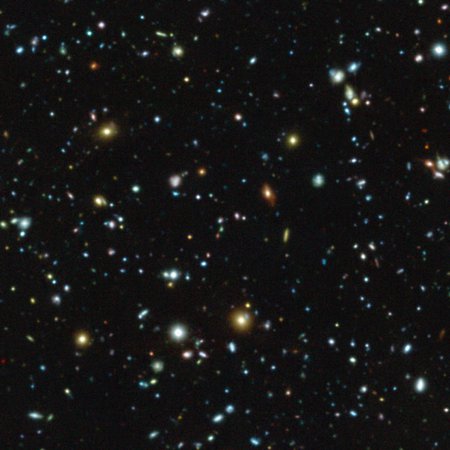The puzzling link between star formation and radio emission in galaxies

Simulation of a forming disk galaxy, in which cosmic rays are accelerated by supernova remnants and then escape into the interstellar medium. Cross sections of the disk (top) and vertical sections (bottom) show the number density of cosmic ray electrons in steady state (left), magnetic field strength (middle) and radio synchrotron brightness.
Credit: Werhahn/AIPOn the 50th anniversary of the discovery of a close connection between star formation in galaxies and their infrared and radio radiation, researchers at the Leibniz Institute for Astrophysics Potsdam (AIP) have now deciphered the underlying physics. To this end, they used novel computer simulations of galaxy formation with a complete modeling of cosmic rays.
To understand the formation and evolution of galaxies like our Milky Way, it is of particular importance to know the amount of newly formed stars in both nearby and distant galaxies. For this purpose, astronomers often use a link between the infrared and radio radiation of galaxies, which has already been discovered 50 years ago: the energetic radiation of young, massive stars that form in the densest regions of galaxies is absorbed by surrounding dust clouds and re-emitted as low-energy infrared radiation. Eventually, when their fuel supply is exhausted, these massive stars explode as supernovae at the end of their lives. In this explosion, the outer stellar envelope is ejected into the environment, which accelerates a few particles of the interstellar medium to very high energies, giving rise to so-called cosmic rays. In the galaxy's magnetic field, these fast particles, traveling at nearly the speed of light, emit very low-energy radio radiation with a wavelength of a few centimetres to metres. Through this chain of processes, newly-forming stars, infrared radiation and radio radiation from galaxies are closely linked.
Although this relation is often used in astronomy, the exact physical conditions are not yet clear. Previous attempts to explain it usually failed in one prediction: if high-energy cosmic rays are indeed responsible for the radio radiation of these galaxies, the theory predicts very steep radio spectra – high emission at low radio frequencies – that do not match observations. To get to the bottom of this mystery, a team of researchers at AIP has now, for the first time, realistically simulated these processes of a forming galaxy on a computer and calculated the cosmic ray energy spectra.
“During the formation of the galactic disk, cosmic magnetic fields are amplified so that they match the strong observed galactic magnetic fields,” explains Professor Christoph Pfrommer, head of the section Cosmology and High-Energy Astrophysics at AIP. When cosmic ray particles in magnetic fields emit radio radiation, it loses part of its energy on its way to us. As a result, the radio spectrum becomes flatter at low frequencies. At high frequencies, in addition to the radio emission of cosmic rays, the radio emission of the interstellar medium, which has a flatter spectrum, also contributes. The sum of these two processes can therefore perfectly explain the observed flat radio radiation of the whole galaxy as well as the emission of the central regions. This also explains the mystery of why the infrared and radio radiation of galaxies are so well linked. “This allows us to better determine the number of newly formed stars from the observed radio emission in galaxies, which will help us to further unravel the story of star formation in the universe,” concludes Maria Werhahn, PhD student at AIP and first author of one of the studies.
Further information
Scientific publications
Cosmic rays and non-thermal emission in simulated galaxies: III. probing cosmic ray calorimetry with radio spectra and the FIR-radio correlation. M. Werhahn, C. Pfrommer, P. Girichidis, 2021, MNRAS, 505, 3295, DOI: https://doi.org/10.1093/mnras/stab2535
Simulating radio synchrotron emission in star-forming galaxies: small-scale magnetic dynamo and the origin of the far infrared-radio correlation. C. Pfrommer, M. Werhahn, R. Pakmor, P. Girichidis, C. M. Simpson, 2022, MNRAS, accepted, https://arxiv.org/abs/2105.12132v2
Images
Simulation of a forming disk galaxy, in which cosmic rays are accelerated by supernova remnants and then escape into the interstellar medium. Cross sections of the disk (top) and vertical sections (bottom) show the number density of cosmic ray electrons in steady state (left), magnetic field strength (middle) and radio synchrotron brightness.
Big screen size [1000 x 483, 780 KB]
Original size [2200 x 1063, 2.9 MB]
Simulation of a forming disk galaxy, in which cosmic rays are accelerated by supernova remnants and then escape into the interstellar medium. Cross sections of the disk (top) and vertical sections (bottom) show the number density of cosmic ray electrons in steady state (left), magnetic field strength (middle) and radio synchrotron brightness. (Image version with labels.)
Big screen size [1000 x 600, 670 KB]
Original size [2070 x 1242, 2.1 MB]
Star formation in galaxies (lower axis) and infrared luminosity (upper axis) are closely related to radio luminosity over many orders of magnitude (vertical axis). Observations (open circles, mean relation is orange dashed) not only agree with simulations (colored symbols) but also with our theoretical expectations (black solid line).
Big screen size [1000 x 1050, 190 KB]
Original size [1200 x 1260, 150 KB]
Radio spectrum of the entire galaxy (top) and its central region (bottom). Shown are the radio emission of cosmic rays (green lines) and of the interstellar medium (magenta line). The sum of these two processes (black line) perfectly explains the observed radio emission (black dots).
Big screen size [1000 x 1200, 220 KB]
Original size [1035 x 1242, 130 KB]






